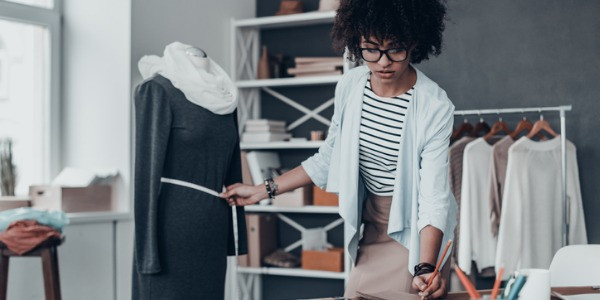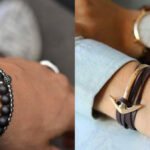Fashion designers are visionaries who translate creative ideas into tangible clothing, accessories, and footwear. They are at the forefront of style trends, shaping how people express themselves through fashion. But beyond the glamour of runways and fashion weeks, the role of a fashion designer is multifaceted and demanding. Their work encompasses a wide range of responsibilities, blending artistic talent with technical skills and industry awareness.
 Fashion designer carefully measuring a dress on a mannequin during the design process. Understanding the duties of a fashion designer in garment creation.
Fashion designer carefully measuring a dress on a mannequin during the design process. Understanding the duties of a fashion designer in garment creation.
Key Responsibilities of a Fashion Designer
The daily tasks of a fashion designer are diverse and can fluctuate depending on their employment level, specialization, and the specific company they work for. However, several core duties are fundamental to the profession:
-
Research and Trend Analysis: Fashion is a constantly evolving industry. Designers must immerse themselves in ongoing research to identify emerging trends, anticipate shifts in consumer tastes, and draw inspiration from a vast array of sources. This includes studying art, history, cultural movements, street style, and competitor designs. They need to be adept at fashion trend forecasting to ensure their designs are relevant and desirable in the market.
-
Conceptualization and Design Development: At the heart of a fashion designer’s role is the ability to conceptualize original and innovative designs. This involves brainstorming ideas, sketching initial concepts, and developing detailed design specifications. Designers often create mood boards to visually represent the inspiration, color palettes, and overall aesthetic of their collections. They must translate their creative vision into sketches, illustrations, and technical drawings that can be understood by pattern makers and production teams.
-
Fabric and Material Selection: Choosing the right fabrics and materials is crucial for both the aesthetic appeal and functionality of a garment. Fashion designers possess a deep understanding of textiles, considering factors such as drape, texture, durability, cost, and suitability for the intended design. They source fabrics, trims, and embellishments, making decisions that balance creativity with practical considerations like production feasibility and budget.
-
Pattern Making and Garment Construction Oversight: While not always directly involved in sewing, fashion designers are integral to the pattern-making and garment construction process. They work closely with pattern makers and sample machinists to ensure their designs are accurately translated into physical prototypes. They oversee fittings, making adjustments and refinements to patterns to achieve the desired silhouette, fit, and functionality. This iterative process of sampling and fitting is essential to perfecting a design before it goes into production.
-
Collaboration and Communication within the Fashion Industry: Fashion design is rarely a solitary pursuit. Designers collaborate extensively with various professionals throughout the fashion ecosystem. This includes working with marketing teams to align designs with brand identity and target audiences, communicating design specifications to manufacturers, and collaborating with stylists and photographers for lookbooks and campaigns. Effective communication skills are vital for conveying design concepts and ensuring a cohesive vision across all stages of the design and production process.
-
Presentation and Sales Activities: Fashion designers often play a role in presenting their collections to buyers, retailers, and the media. This can involve participating in fashion shows, creating lookbooks, and attending sales appointments. They need to articulate their design vision and understand the commercial aspects of the fashion business, including pricing, production costs, and market demand. For designers who run their own brands, sales and marketing are critical aspects of their role.
-
Quality Control and Production Monitoring: To maintain brand standards and ensure customer satisfaction, fashion designers are often involved in overseeing the production process. They establish quality control standards, review samples from manufacturers, and address any production issues that may arise. This attention to detail ensures that the final garments meet the designer’s specifications and the brand’s quality expectations.
-
Brand Development and Identity: For designers working with established brands or building their own labels, brand management is a significant responsibility. They contribute to shaping the brand’s aesthetic, values, and market positioning. Their designs must consistently reflect the brand’s identity and resonate with the target consumer. Fashion designers contribute to building brand recognition and loyalty through their creative output.
Diverse Types of Fashion Designers
The fashion industry is vast, and fashion designers often specialize in specific niches. Here are some common types of fashion designers, highlighting the diversity within the profession:
-
Ready-to-Wear Designers: These designers create commercially viable clothing lines that are mass-produced and sold in retail stores. They focus on creating fashionable and functional garments that appeal to a broad consumer base, balancing creativity with market demands.
-
Haute Couture Designers: At the pinnacle of fashion, haute couture designers create exclusive, custom-made garments for individual clients. This is the realm of high fashion, characterized by intricate craftsmanship, luxurious materials, and runway artistry. Haute couture designers are driven by creativity and artistry, pushing the boundaries of fashion design.
-
Streetwear Designers: Streetwear designers focus on casual, urban-inspired clothing that reflects current youth culture and trends. They often incorporate elements of sportswear, hip-hop fashion, and skate culture, creating designs that are both fashionable and comfortable for everyday wear.
-
Sportswear Designers: With the growing emphasis on fitness and active lifestyles, sportswear designers create clothing specifically for athletic activities. They focus on performance fabrics, functional designs, and comfort, blending style with practicality for sports and exercise.
-
Accessory Designers: Accessory designers specialize in creating items that complement clothing, such as handbags, shoes, jewelry, hats, and belts. They understand how accessories can complete and elevate an outfit, focusing on both design aesthetics and functionality in their creations.
-
Textile Designers: Textile designers focus on the artistic and technical aspects of fabric creation. They design patterns, prints, and textures for fabrics used in clothing, home furnishings, and other products. Their expertise lies in understanding fabric construction, dyes, and printing techniques, contributing significantly to the overall look and feel of fashion garments.
-
Costume Designers: Costume designers work in the entertainment industry, creating clothing for theater, film, television, and dance productions. They collaborate closely with directors and actors to develop costumes that accurately reflect characters, time periods, and narratives, bringing stories to life through clothing.
-
Sustainable Fashion Designers: With increasing environmental awareness, sustainable fashion designers prioritize ethical and eco-friendly practices. They focus on using recycled or organic materials, minimizing waste, and promoting fair labor practices in the fashion industry, creating designs that are both stylish and responsible.
In conclusion, the role of a fashion designer is dynamic and multifaceted, requiring a blend of artistic talent, technical knowledge, business acumen, and a deep understanding of the ever-changing fashion landscape. From conceptualization to production and presentation, fashion designers are central figures in shaping the visual culture of our world.
